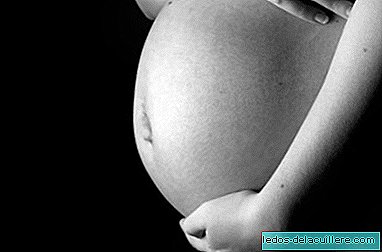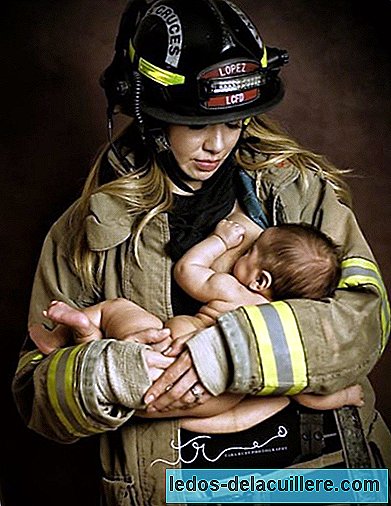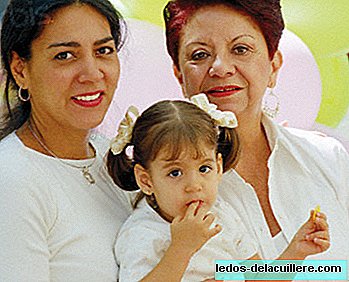
Our section arrives: Ask the midwife With a little delay this week we usually publish it on Fridays. Midwife Marina Fernández collaborates with Babies and more and every week answers a question related to pregnancy, childbirth, postpartum or breastfeeding that our readers leave for her. This week we are going to talk about the blood group incompatibility and HR.
Marina Fernandez She is a midwife, specializing in home birth, a lactation consultant and an expert in complementary therapies. She is a member of the Professional Association Born at Home and a founding partner of Multilacta.Each week he will collaborate with Babies and more by answering a question from our readers. You can know her better on her Marina Matrona page.
The question we have selected this week to answer the midwife Marina Fernández It is a concern that couples often have: the possible incompatibility of blood group and HR. It is about this:
Hello, I have a baby and when he was born he was hospitalized because he had very high bilirubin, because they told me it was because of blood incompatibility I am O positive and my baby A positive as my husband, my question is that IF WE WANT TO HAVE A SECOND BABY WILL WE HAVE COMPLICATIONS? Thanks for your help.
Midwife Marina Fernández answers the question, also with the collaboration of the doctor in gynecology Emilio Santos and will explain when they are incompatible blood groups and HR of a couple who want to be parents.
"We are going to explain a series of very interesting topics: group and Rh incompatibility, hemolytic disease of the newborn, its treatment and prevention.
Blood groups
There are 8 blood groups depending on the presence or not of three substances on the surface of the red blood cells. The three substances are: the A antigen, the B antigen and the Rh system (it was initially called a Rh factor but then it was learned that it is not just one but a whole antigen system, of which the main one is the D antigen) .
Depending on whether or not a person has each of these three substances, it is classified into one of eight blood groups. In order of frequency in the Spanish population, blood groups are those that appear in the table:

* (Source: Spanish Federation of Blood Donors)
As a curiosity, the country in the world where more Rh-people live is Spain (approximately 19% of the population); in the Basque Country .
The substances A, B and Rh are antigens. This means that they induce an immune response against them if they are introduced into the blood of a person who does not have them. This immune response is severe and can lead to hemolysis (destruction of red blood cells), anemia, renal failure, shock, or death. This immune response only occurs if blood is received from certain blood groups.
We will now see some examples:
Example 1. People with blood from the AB + group have red blood cells that express type A antigens, type B antigens and Rh surface antigens; they are not able to produce antibodies against said A, B or Rh antigens. Therefore they admit blood transfusions of any group. The AB + group is the universal receiver.
Example 2 . People with group 0- blood have red blood cells that do NOT express type A antigens, type B antigens or Rh antigens on their surface; they are capable of producing antibodies against said A, B or Rh antigens. Therefore, they only admit blood transfusions from their own group 0-. If they receive blood from another group they would produce an immune rejection reaction. Your immune system behaves against those red blood cells as if they were threatening bacteria. Group 0- is the universal donor.
Example 3. People with group 0+ blood have red blood cells that do not express A or B antigens, but do express Rh antigens. They can donate their blood to people in the group 0+, A +, B + or AB +, but they cannot donate to people 0-, A-, B- or AB-.
First, groups 0, A, B and AB were discovered in 1901. And they began to be taken into account when the first blood transfusions were performed. The Rh antigen was discovered later, in 1941, by the hematologists Landsteiner and Wiener, who using sera from rabbits and guinea pigs immunized by red blood cells from the Macacus Rhesus, found that the antibodies contained in the sera, in addition to agglutinating the red blood cells of the Rhesus , produced the same effect on the blood of 85% of the white population of New York. This discovery came to respond to the rate of failures that occurred in blood transfusions that were performed strictly respecting the incompatibilities between the classic blood groups (A, B, AB and 0, regardless of Rh).
Incompatibility of group and Rh
The incompatibility of groups AB0 it has almost no significance in pregnancy, between mother and baby; When it has consequences, they are usually mild.
Instead the Rh incompatibilityyeah When a mother is nursing a baby, small amounts of the baby's blood can pass to the mother and an immune rejection reaction of the mother's blood against that of the baby can occur.
Being very small amounts, it almost never happens if it is the first time. This serious consequence only occurs if previously (years before) Rh sensitization has occurred.
Rh sensitization is the process by which the mother develops anti-Rh antibodies in response to the Rh antigen. Rh sensitization occurs if that Rh negative mother sometime before that pregnancy has been in contact with the Rh antigen system, that is, basically, if she has received a Rh + blood transfusion or if she has previously had another pregnancy with an Rh baby positive.
A Rh group incompatibility (Rh-negative mother previously sensitized with Rh-positive baby) can lead to a reaction of the mother's immune system against that of the baby that causes severe anemia in the baby by destruction of her red blood cells.
Rh incompatibility occurs when the mother is Rh- and the father Rh +, which happens in our environment in approximately 12% of couples. The problem occurs when the fetus inherits the Rh + character, which will occur in 100% of couples if the father is homozygous for the Rh antigen (D / D genotype), and only 50% if the father is heterozygous (genotype D / d).
Hemolytic disease of the newborn
It is the consequence of an attack of your immune system on your baby's blood cells. He will be born pale due to anemia, or yellow due to excess bilirubin (Kernícterus) from the breakage of red blood cells, would have a large liver and spleen, due to the extra overload that these organs would perform, he will have difficulty breathing.
The hemolytic disease When the baby is still inside the uterus, it is called fetal erythroblastosis or hydrops, which would be recognized on ultrasound by edema (swelling) of the entire body. Fetal erythroblastosis and hemolytic disease were a frequent cause of death of babies in past centuries and today are rare thanks to anti-Rh gammaglobulin.
Hemolytic disease treatment
He hemolytic disease treatment It depends on the severity. If the hemolytic disease is mild, it will be enough to wait for the birth and ensure the newborn intensive hydration and phototherapy. When the red blood cells are broken, there is an excess of hemoglobin that is metabolized to bilirubin and sunlight helps the newborn metabolize excess bilirubin.
The severity of hemolytic disease is determined by a Doppler ultrasound of the baby's middle cerebral arteries. If the hemolytic disease is severe, an intrauterine blood transfusion will have to be performed on the baby, labor may have to be induced, an exchange transfusion may be performed on the newborn, and fluid retention and possible insufficiency should be monitored. congestive heart
Prevention of hemolytic disease: Anti-D gammaglobulin (the "Rh" vaccine)
It is enough to avoid Rh sensitization in all women to avoid cases of severe Rh incompatibility syndrome. For this, the precaution that is taken inexcusably is that every pregnant woman in the Rh group is given a dose of anti-Rh antibodies (specifically, anti-D gammaglobulin).
It should be done at the age of 28 weeks, at birth of the baby (there is a period of 72 hours and it is not necessary if it is proven that the baby is Rh-) or when it has any process that could potentially involve mother-baby blood exchange, as per example, abortion, ectopic pregnancy, vaginal bleeding, chorion biopsy, amniocentesis, abdominal trauma, or external cephalic version.
The Coombs test
It is a screening of antibodies related to hemolytic disease. It is performed in the first analysis to all pregnant women, to detect sensitization to rare antigens. And if you are Rh - in the analytics of the three quarters. If it is positive, the responsible antigen is identified. If antibodies are discovered before week 20, sensitization is considered to have occurred before this gestation.
The test is that, in the laboratory, successive dilutions of a serum sample are made: at 1/2, 1/4, 1/8… At a certain degree of dilution (technically called titration) antibodies are no longer detected. A titre of 1/16, 1/32 or more indicates risk of fetal involvement. If it is less than 1/16 it is repeated in four weeks.
If the test is greater than 1/16, there is a risk that the baby will suffer from hemolytic disease. In this case, with a Doppler ultrasound the maximum systolic velocity in the middle cerebral artery is measured, to see if the baby suffers from anemia. If it is severe, a transfusion is done through cordocentesis or pregnancy is terminated if it exceeds 34 weeks. "
We hope that the response that this week was given by the midwife Marina Fernández, with the support of Dr. Emilio Santos this week, has been useful to you and you can better understand the incompatibility of HR and its treatment.
We encourage you to continue leaving here ask our midwife and next Friday we will meet again with another of his interesting answers.












